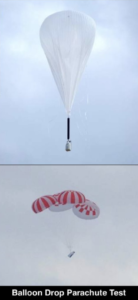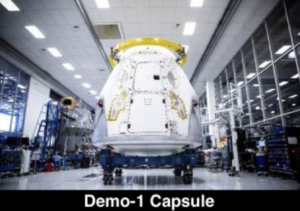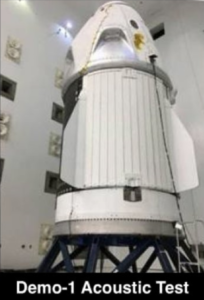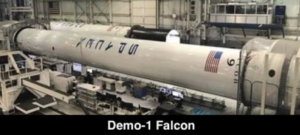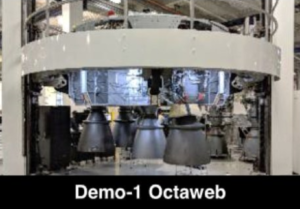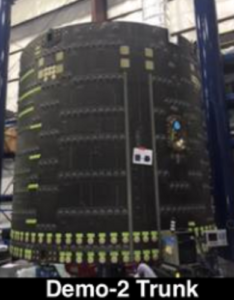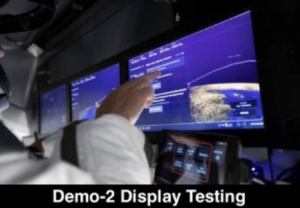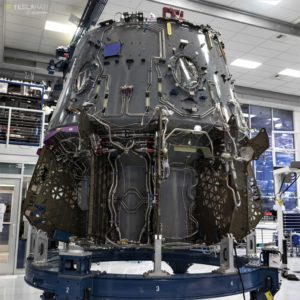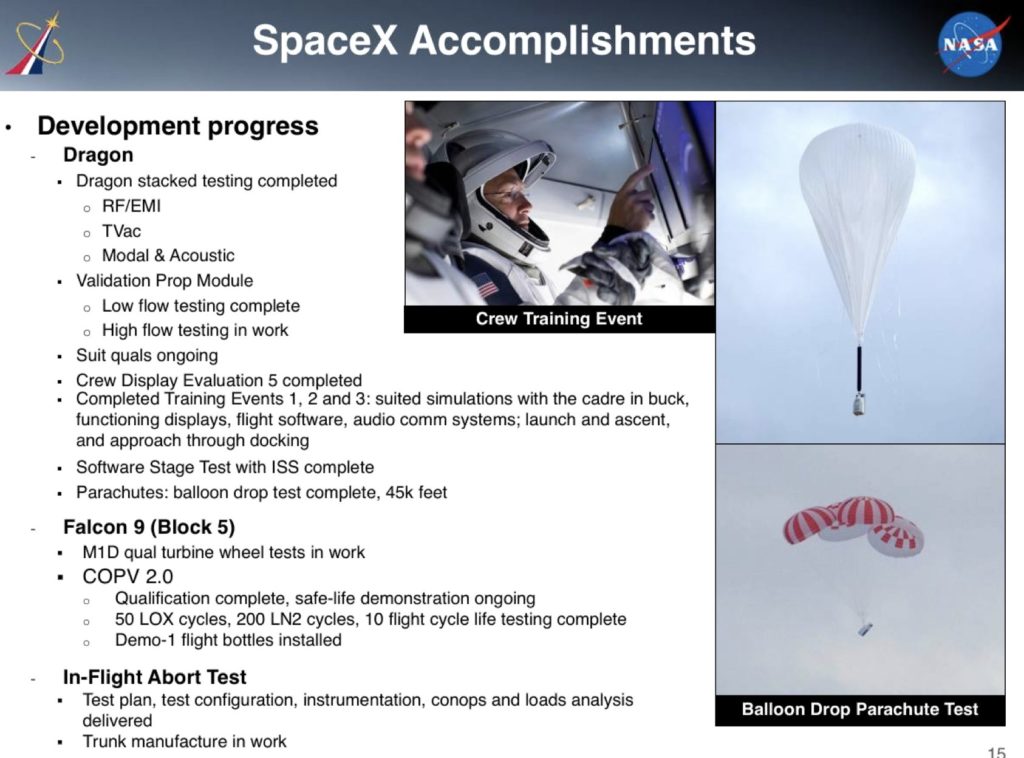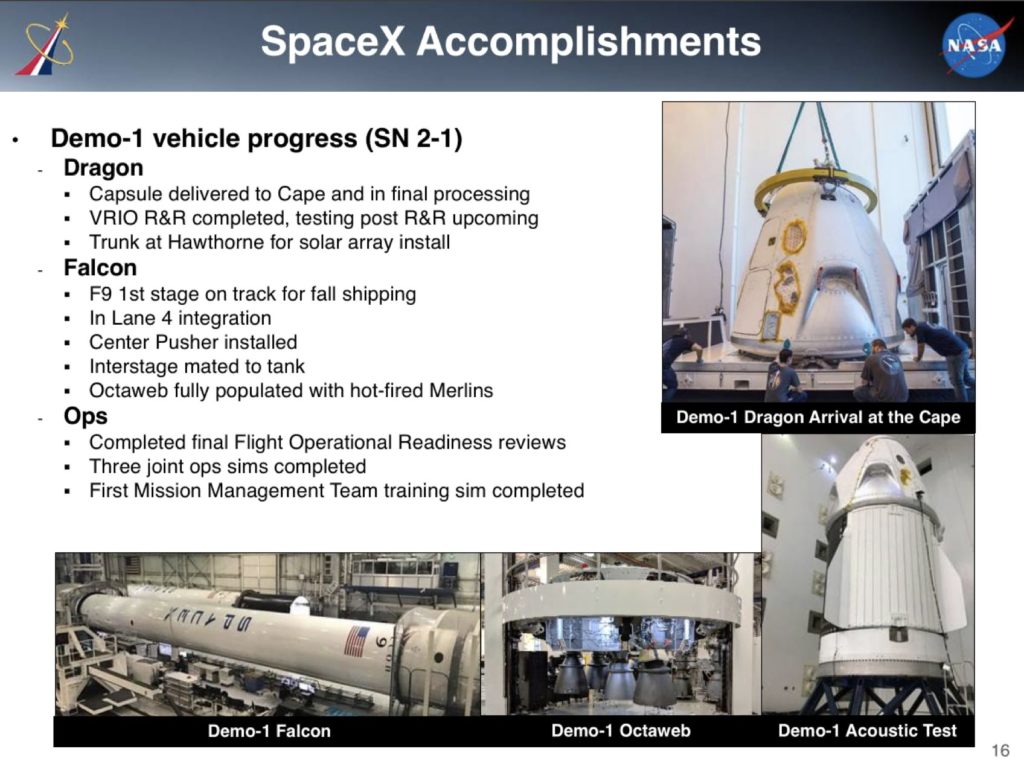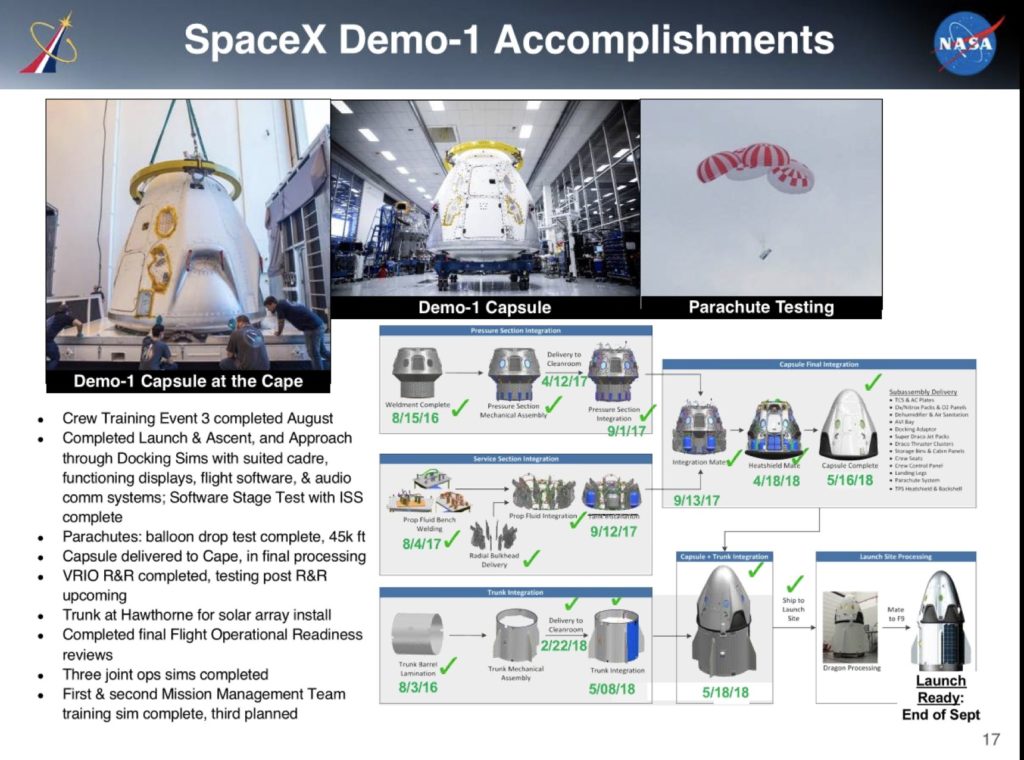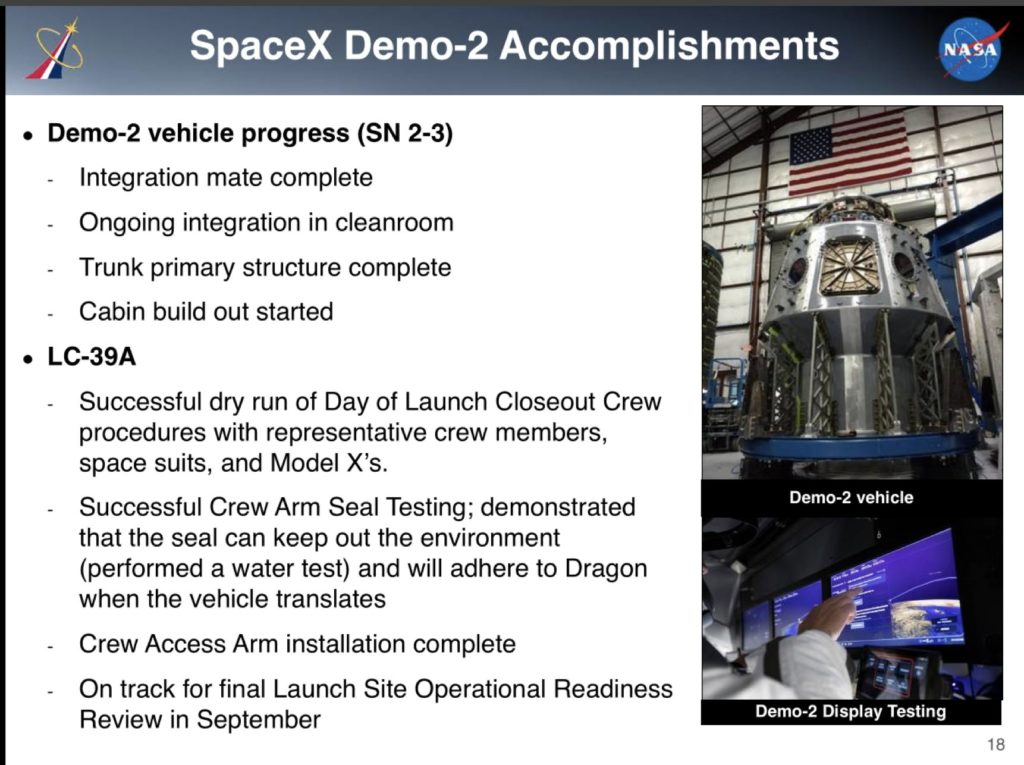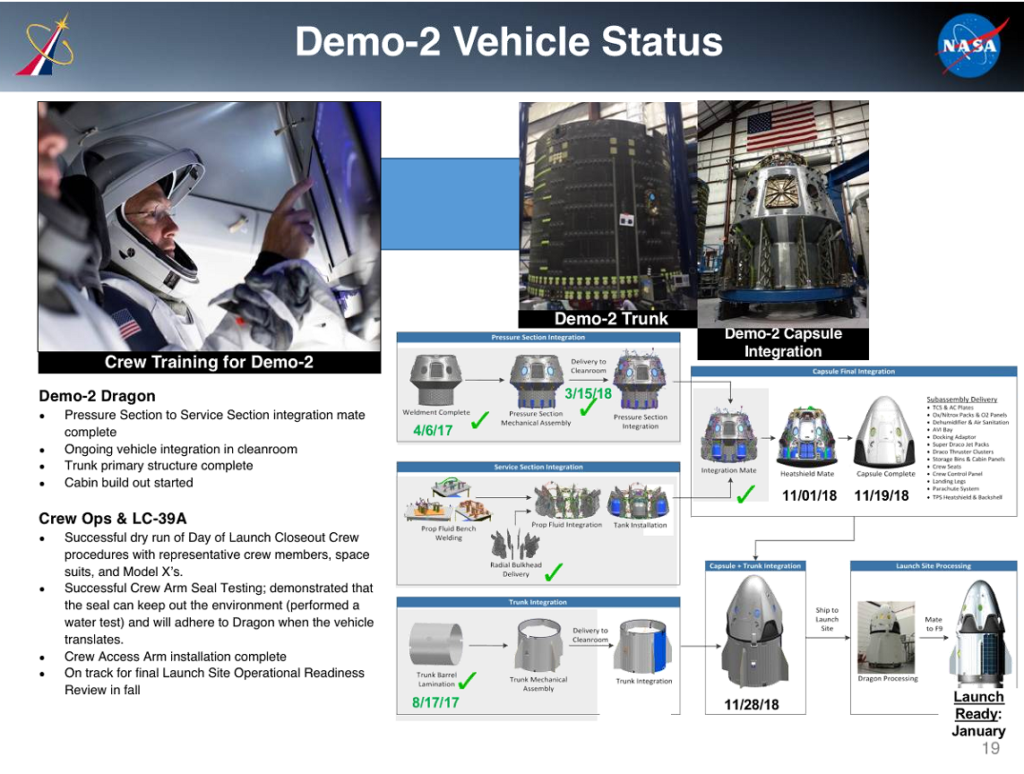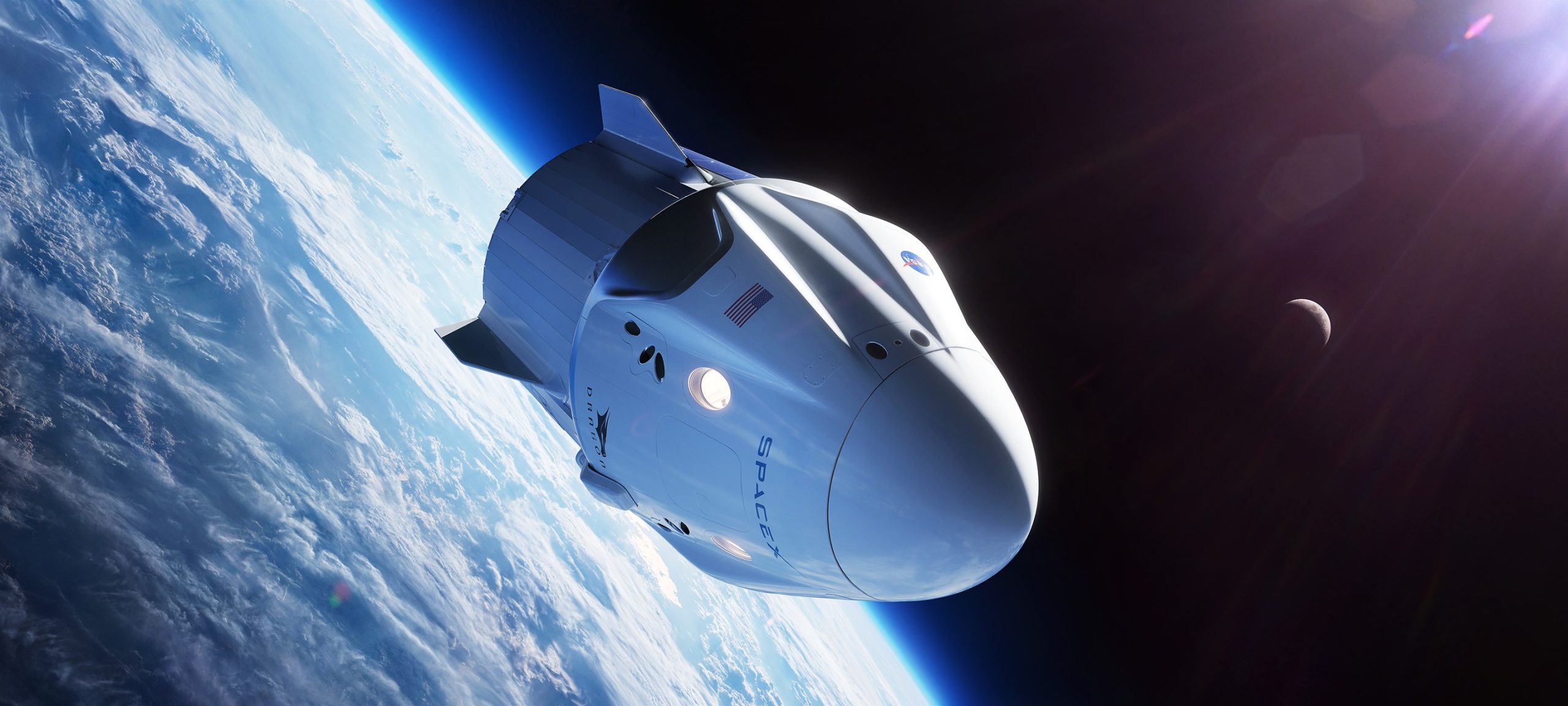
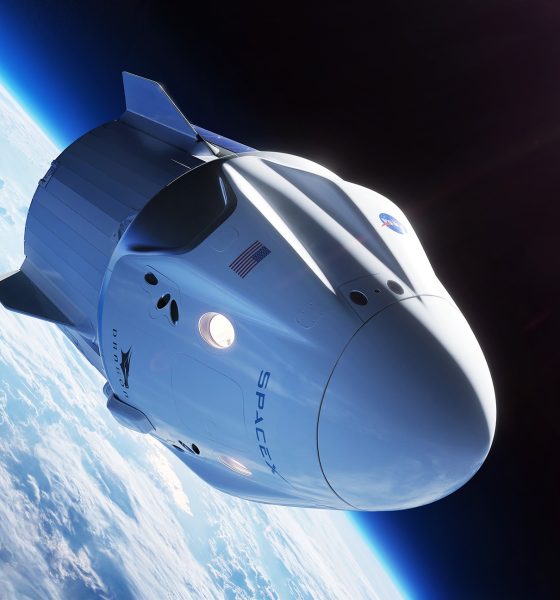
SpaceX
SpaceX’s Crew Dragon and Falcon 9 Block 5 rocket are almost ready for astronauts
In a Commercial Crew update presented by Program Manager Kathy Lueders to the NASA Advisory Council (NAC), the agency has confirmed that SpaceX is deep into the final stages of hardware preparation and testing ahead of their first uncrewed and crewed demonstrations launches of Crew Dragon.
Barring a miracle for Commercial Crew Program partner Boeing’s Starliner spacecraft program or serious faults leading up to SpaceX’s own debuts, SpaceX is all but guaranteed to become the first private company in history to design, build, and launch a spacecraft into Earth orbit with real astronauts onboard.
PICTURE OF B1051!!! It will ship to the Cape from McGregor soon.
Solar panel array on the trunk for the DM-1 capsule will take place in Hawthorne. pic.twitter.com/K82GANn5zr
— Michael Baylor (@MichaelBaylor_) August 27, 2018
SpaceX’s DM-1 Crew Dragon (serial number C201; “C” for capsule, “2” for Dragon 2, and “01” for capsule #1) capsule is already in Florida at one of the company’s spacecraft processing facilities, while that vehicle’s trunk segment – a module mounted below the capsule responsible for providing power (solar arrays), thermal regulation (radiator panels), and external cargo lift capacity – is scheduled to ship from Hawthorne, CA to Florida by the end of September. Demonstration Mission-1 (DM-1) is currently targeting a launch debut no earlier than November 2018.
DM-1’s Falcon 9 launch vehicle, booster B1051 and an expendable second stage, are also making significant progress towards the Crew Dragon’s uncrewed debut launch. NASA’s report noted that B1051 was on track for shipment (presumably to the Cape) sometime in the fall (technically anytime after August 31st) and that the upper stage would likely find its way to Florida soon after, sometime in September. Due to the fact that Merlin Vacuum engine qualification has not yet been completed, that milestone is likely the only thing standing between S2 shipment to FL, as SpaceX typically builds and tests both Falcon 9 segments near-simultaneously.
- One of the aforementioned balloon-drop parachute tests. (SpaceX)
- The DM-1 Crew Dragon capsule soon after completion. (SpaceX)
- DM-1 seen conducting acoustic testing in Ohio. (SpaceX)
- Falcon 9 B1051, DM-1’s rocket of choice, seen during construction in SpaceX’s Hawthorne factory. (SpaceX)
- B1051’s octaweb, the structure that Merlin engines attach to and thrust against. (SpaceX)
- The DM-2 Crew Dragon’s trunk module seen during production. (SpaceX)
- Crew Dragon astronauts test the capsule’s display controls. (SpaceX)
- SpaceX Crew Dragon capsule C203 – then assigned DM-2 – is seen here in August 2018. (Pauline Acalin)
Meanwhile, SpaceX has successfully completed a duo of unique and critical tests of Crew Dragon’s parachute systems, carrying a Crew Dragon mass simulator (i.e. boilerplate) up to 45,000 feet (13,700 m) under a huge balloon before dropping the mockup, a test series designed to prove out the ability of the parachute system to successfully deploy and function in the exact flight regimes the real hardware will experience while safely returning astronauts to Earth. As NASA Commercial Crew Program Manager Kathy Lueders herself noted, that type of testing is extremely difficult to pull off, but SpaceX has thus far completed two.
On the launch pad side of things, SpaceX will be exclusively conducting Crew Dragon missions from Pad 39A. The company completed installation of a strikingly modern-looking crew access arm (CAA) just days ago, marking a crucial milestone for the historic launch complex to be truly ready to support human spaceflight once more, a heritage represented physically by the tower the arm is installed on (Shuttle-era) and the pad’s foundation and thrust diverter (constructed to support Saturn V’s Apollo moon missions).
That’s right provided the two Crew Dragon test flights go well. Hardware will def be ready. https://t.co/KcAFArYn1x
— Elon Musk (@elonmusk) August 6, 2018
Further down the road, SpaceX has already entered into the late stages of hardware integration and preparation for the second Crew Dragon demonstration mission (DM-2), which will almost without a doubt see SpaceX become the first private entity in history to build, launch, and operate a crewed spacecraft in Earth orbit.
According to NASA’s SpaceX-derived schedule, that particularly historic spacecraft is expected to be ready for launch as early as January, a full three months prior to its current April 2018 launch date. CEO Elon Musk did note recently on Twitter that the hardware for both crewed and uncrewed demonstration missions would “def[initely] be ready” for the launch dates of November 2018 and April 2019.
Catch all the technical SpaceX-related slides below.
- August 27, 2018. (NASA)
- August 27, 2018. (NASA)
- August 27, 2018. (NASA)
- August 27, 2018. (NASA)
- August 27, 2018. (NASA)
For prompt updates, on-the-ground perspectives, and unique glimpses of SpaceX’s rocket recovery fleet check out our brand new LaunchPad and LandingZone newsletters!

News
Tesla hints at Starlink integration with recent patent
“By employing polymer blends, some examples enable RF transmission from all the modules to satellites and other communication devices both inside and outside the vehicle.”

Tesla hinted at a potential Starlink internet terminal integration within its vehicles in a recent patent, which describes a vehicle roof assembly with integrated radio frequency (RF) transparency.
The patent, which is Pub. No U.S. 2025/0368267 describes a new vehicle roof that is made of RF-transparent polymer materials, allowing and “facilitating clear communication with external devices and satellites.”
Tesla believes that a new vehicle roof design, comprised of different materials than the standard metallic or glass elements used in cars today, would allow the company to integrate modern vehicular technologies, “particularly those requiring radio frequency transmission and reception.
Tesla has recently filed a US patent application on integrating RF transparent materials into the roof structure.
“facilitating clear communication with external devices and satellites”
Tesla fleet is getting @Starlink connectivity integration soon. LFG @Tesla @elonmusk… pic.twitter.com/bLa8YtPLd1
— Chansoo Byeon (@Chansoo) December 9, 2025
Instead of glass or metallic materials, Tesla says vehicles may benefit from high-strength polymer blends, such as Polycarbonate, Acrylonitrile Butadiene Styrene, or Acrylonitrile Styrene Acrylate.
These materials still provide ideal strength metrics for crashworthiness, stiffness for noise, vibration, and harshness control, and are compliant with head impact regulations.
They would also enable better performance with modern technologies, like internet terminals, which need an uninterrupted signal to satellites for maximum reception. Tesla writes in the patent:
“By employing polymer blends, some examples enable RF transmission from all the modules to satellites and other communication devices both inside and outside the vehicle.”

One of the challenges Tesla seems to be aware of with this type of roof design is the fact that it will still have to enable safety and keep that at the forefront of the design. As you can see in the illustration above, Tesla plans to use four layers to increase safety and rigidity, while also combating noise and vibration.
It notes in the patent that disclosed examples still meet the safety requirements outlined in the Federal Motor Vehicle Safety Standards (FMVSS).
Starlink integrated directly into Tesla vehicles would be a considerable advantage for owners. It would come with a handful of distinct advantages.
Initially, the inclusion of Starlink would completely eliminate cellular dead zones, something that is an issue, especially in rural areas. Starlink would provide connectivity in these remote regions and would ensure uninterrupted service during road trips and off-grid adventures.
It could also be a critical addition for Robotaxi, as it is crucial to have solid and reliable connectivity for remote monitoring and fleet management.
Starlink’s growing constellation, thanks to SpaceX’s routine and frequent launch schedule, will provide secure, stable, and reliable internet connectivity for Tesla vehicles.
Although many owners have already mounted Starlink Mini dishes under their glass roofs for a similar experience, it may be integrated directly into Teslas in the coming years, either as an upgrade or a standard feature.
Investor's Corner
SpaceX IPO is coming, CEO Elon Musk confirms
However, it appears Musk is ready for SpaceX to go public, as Ars Technica Senior Space Editor Eric Berger wrote an op-ed that indicated he thought SpaceX would go public soon. Musk replied, basically confirming it.

Elon Musk confirmed through a post on X that a SpaceX initial public offering (IPO) is on the way after hinting at it several times earlier this year.
It also comes one day after Bloomberg reported that SpaceX was aiming for a valuation of $1.5 trillion, adding that it wanted to raise $30 billion.
Musk has been transparent for most of the year that he wanted to try to figure out a way to get Tesla shareholders to invest in SpaceX, giving them access to the stock.
He has also recognized the issues of having a public stock, like litigation exposure, quarterly reporting pressures, and other inconveniences.
However, it appears Musk is ready for SpaceX to go public, as Ars Technica Senior Space Editor Eric Berger wrote an op-ed that indicated he thought SpaceX would go public soon.
Musk replied, basically confirming it:
As usual, Eric is accurate
— Elon Musk (@elonmusk) December 10, 2025
Berger believes the IPO would help support the need for $30 billion or more in capital needed to fund AI integration projects, such as space-based data centers and lunar satellite factories. Musk confirmed recently that SpaceX “will be doing” data centers in orbit.
AI appears to be a “key part” of SpaceX getting to Musk, Berger also wrote. When writing about whether or not Optimus is a viable project and product for the company, he says that none of that matters. Musk thinks it is, and that’s all that matters.
It seems like Musk has certainly mulled something this big for a very long time, and the idea of taking SpaceX public is not just likely; it is necessary for the company to get to Mars.
The details of when SpaceX will finally hit that public status are not known. Many of the reports that came out over the past few days indicate it would happen in 2026, so sooner rather than later.
But there are a lot of things on Musk’s plate early next year, especially with Cybercab production, the potential launch of Unsupervised Full Self-Driving, and the Roadster unveiling, all planned for Q1.
News
SpaceX reportedly mulling IPO, eyeing largest of all time: report
“I do want to try to figure out some way for Tesla shareholders to participate in SpaceX. I’ve been giving a lot of thought to how to give people access to SpaceX stock,” Musk said.

SpaceX is reportedly mulling an initial public offering, eyeing what would be the largest valuation at the time of availability of all time, a new report from Bloomberg said on Tuesday.
It is one of many reports involving one of Elon Musk’s companies and a massive market move, as this is not the first time we have seen reports of an IPO by SpaceX. Musk himself has also dispelled other reports in the past of a similar nature, including an xAI funding round.
SpaceX and Musk have yet to comment on the report. In the past, untrue reports were promptly replied to by the CEO; this has not yet gained any response, which is a good sign in terms of credibility.
However, he said just a few days ago that stories of this nature are inaccurate:
“There has been a lot of press claiming SpaceX is raising money at $800B, which is not accurate. SpaceX has been cash flow positive for many years and does periodic stock buybacks twice a year to provide liquidity for employees and investors. Valuation increments are a function of progress with Starship and Starlink and securing global direct-to-cell spectrum that greatly increases our addressable market. And one other thing that is arguably most significant by far.”
There has been a lot of press claiming @SpaceX is raising money at $800B, which is not accurate.
SpaceX has been cash flow positive for many years and does periodic stock buybacks twice a year to provide liquidity for employees and investors.
Valuation increments are a…
— Elon Musk (@elonmusk) December 6, 2025
Musk has discussed a potential IPO for SpaceX in recent months, as the November 6 shareholder meeting, as he commented on the “downsides” of having a public company, like litigation exposure, quarterly reporting pressures, and other inconveniences.
Nevertheless, Musk has also said he wants there to be a way for Tesla shareholders to get in on the action. At the meeting in early November, he said:
“I do want to try to figure out some way for Tesla shareholders to participate in SpaceX. I’ve been giving a lot of thought to how to give people access to SpaceX stock.”
Additionally, he added:
“Maybe at some point., SpaceX should become a public company despite all the downsides of being public.”
Musk has been historically reluctant to take SpaceX public, at times stating it could become a barrier to colonizing Mars. That does not mean it will not happen.
Bloomberg’s report cites multiple unidentified sources who are familiar with the matter. They indicate to the publication that SpaceX wants to go public in mid-to-late 2026, and it wants to raise $30 billion at a valuation of around $1.5 trillion.
This is not the first time SpaceX has discussed an IPO; we reported on it nine years ago. We hope it is true, as the community has spoken for a long time about having access to SpaceX stock. Legendary investor Ron Baron is one of the lucky few to be a SpaceX investor, and said it, along with Tesla, is a “lifetime investment.”
Tesla bull Ron Baron reveals $100M SpaceX investment, sees 3-5x return on TSLA
The primary driver of SpaceX’s value is Starlink, the company’s satellite internet service. Starlink contributes 60-70 percent of SpaceX’s revenue, meaning it is the primary value engine. Launch services, like Falcon 9 contracts, and the development of Starship, also play supporting roles.
